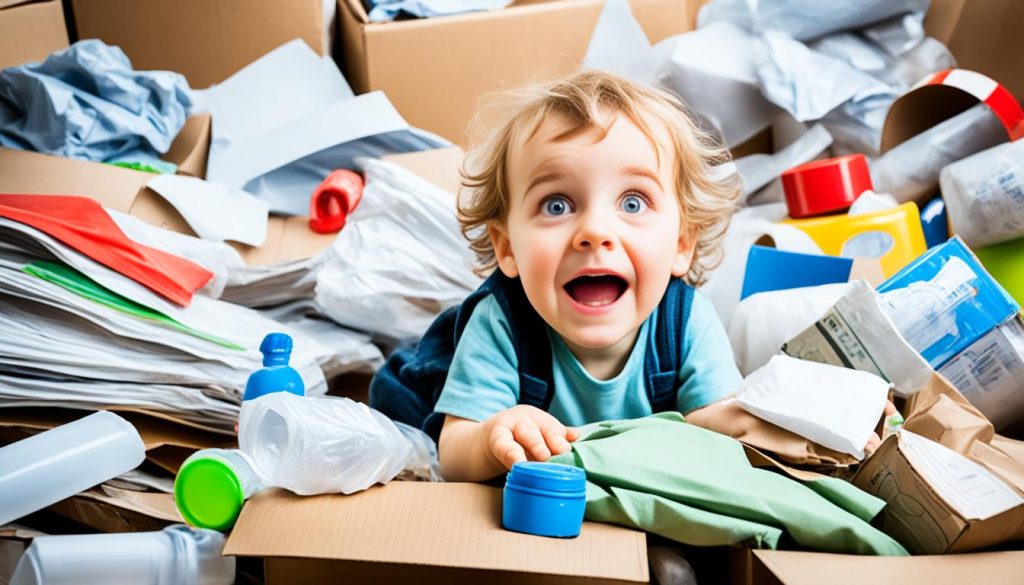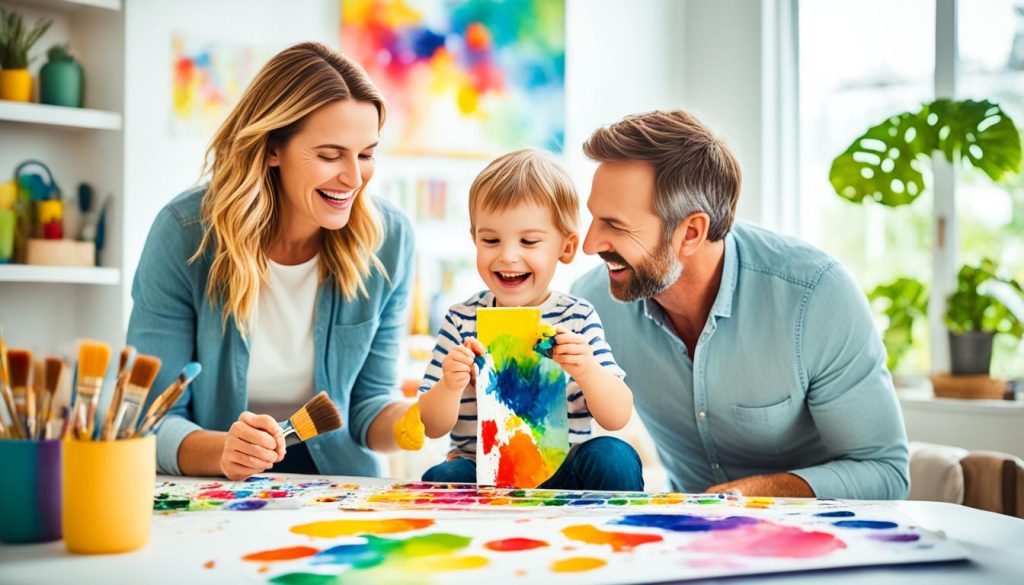Imagine seeing your child turn a simple cardboard box into a spaceship or build a castle with everyday items. It’s a joy to see your child’s imagination come alive. You play a big part in helping them be creative. Many parents find that simple, creative play is more appealing than complex gadgets.
This shows how important it is to engage your child’s imagination. It also shows how crucial parenting is in helping kids be creative.
Imaginative play is key to your child’s growth. Professor Paul Harris at Harvard found that it brings joy and helps kids understand the world. By doing creative activities, you help your child grow emotionally, cognitively, and socially.
Creative play lets kids surprise each other and change ideas. It turns everyday items into tools for imagination. You can use household items for new stories or play with toys like Playper’s Curious Kingdom characters. This encourages your child’s creativity to grow.
Key Takeaways
- Children exposed to a variety of activities, toys, and books are more likely to develop their creative strengths.
- Embracing challenges and normalizing failure support resilience and originality in creative endeavors.
- Providing appropriate challenges and setting goals helps develop a growth mindset essential for nurturing creativity.
- Parents who model persistence and perseverance positively influence their children’s creative mindset.
- Interactive and imaginative play using household items enhances emotional and cognitive development.
The Importance of Imaginative Play
Imaginative play is more than just fun for kids. It’s key to their growth. It helps them understand reality, deal with fears, and know the difference between make-believe and real life. This kind of play also helps kids manage their feelings, leading to better focus and less stress.

Benefits for Emotional Intelligence
Imaginative play boosts critical thinking and social skills in kids. A 2013 study found in The Telegraph showed that imaginative kids are more emotionally connected and understanding. They also handle emotions better, showing less selfishness and anger, and do well on emotional tests.
Melissa Bernstein, from Melissa & Doug, pointed out in 2016 the issue with technology taking away kids’ free time. This makes it harder for parents to help their kids develop emotionally.
Building Self-Esteem Through Creativity
Creative play helps kids feel good about themselves. Through arts, crafts, and stories, they express themselves and feel proud of their work. This kind of play also improves hand-eye coordination and fine motor skills, boosting their confidence.
Positive reinforcement from parents during these activities can make kids feel even better about themselves. It’s important for parents to support their kids’ growth in imaginative play. This strengthens their bond and helps with emotional and social development.
Research shows that imaginative play makes kids more thoughtful and understanding. This helps them in social situations and with their emotional health.
Encouraging Storytelling and Narrative Building
Storytelling and narrative building can really help a child grow. Reading books every day helps your child learn about sounds, words, and language. This boosts their brain development and helps with social, communication, and emotional skills.
Starting early with these activities supports different learning styles. It also makes their thinking skills better.
Creative Storytelling Prompts
Parents can improve their bond with their child through creative storytelling. Begin by reading a book together and then ask questions about the story and characters. Encourage your child to think of new endings or continue the characters’ stories.
This fun way of engaging makes reading unforgettable. It also helps grow their creativity.
Try these ideas:
- Ask your child to guess what comes next in the story.
- Have them add a new character to the story.
- Use household items to act out favorite story scenes.
- Turn family stories into tales your kids will love.

Using Books as a Springboard
Books are great for sparking creativity in kids. After reading, talk about the story’s themes, settings, and characters. This makes them think more deeply and boosts their understanding.
Studies show that stories, songs, and rhymes help with language and reading skills. Libraries are full of free books and activities that can spark your child’s interest.
Parents are crucial in this process. Doing arts and crafts based on the stories you read can make learning even better. For example, after reading a book, make a craft that matches the story. This makes learning fun and helps your child’s unique way of thinking.
Utilizing Household Items for Creative Play
Playing with everyday items is both fun and good for kids. It boosts their curiosity, creativity, and problem-solving skills. This way of playing is great for parents and kids to bond. It also teaches kids important life lessons about being independent.

Simple Objects with Big Potential
Things like spoons, bowls, and cardboard boxes can turn into many creative tools. For example, a box can be a spaceship, and a spoon can be a magic wand. This shows how everyday items can help kids learn to be independent and creative.
Repurposing Everyday Items
Turning everyday objects into something new teaches kids about being resourceful and responsible. Using a bowl as a helmet or a stick as a microphone shows how to use what you have. This kind of play also helps kids appreciate the value of simple things.
| Age Group | Activity | Development Benefits |
|---|---|---|
| Babies | Sensory play with safe kitchen items | Enhances sensory development and curiosity |
| Toddlers | Building blocks with boxes | Improves motor skills and problem-solving |
| Preschoolers | Imaginative play with repurposed objects | Boosts creativity and emotional understanding |
| School-age children | Crafting projects with recycled materials | Encourages fine motor skills and creativity |
Using household items for play is fun and teaches kids about responsibility. Creative activities with parents help kids learn and grow. They make sure kids are well-rounded and enjoy the simple things in life.
Parenting and Raising Kids Through Imaginative Activities
As a parent, using imaginative activities with your child has many benefits. It boosts creativity and helps with mental health and growth. By playing together, parents can help kids deal with the digital age. They can balance screen time with offline fun.
This way, parents can model creativity and help their kids grow. Let’s see how this can make a difference.

Modeling Creativity for Your Child
Modeling creativity is key in positive parenting. In the 1920s, experts said parents should stay out of kids’ play to help them be independent. But, as time went on, parents started playing with their kids more. Now, we know that playing together is good for kids.
Playing with toys or making things up teaches kids about the power of play. It’s important for their feelings and well-being.
Fostering Independence and Creative Thought
Helping kids be independent means guiding them in exploring on their own. Simple things like using a glue gun or doing science experiments can teach them a lot. They become more confident.
Some families prefer organized activities, but free play is great too. It lets kids be more spontaneous and happy. Making things like a xylophone from paper tubes or a gnome house lets them learn and have fun on their own.
Cultures differ in how parents play with their kids. In some places, it’s seen as wrong, in others, it’s key for learning. But the main thing is clear. Good parenting means finding a balance that helps kids’ mental health and encourages them to think creatively on their own.
| Activity | Benefits |
|---|---|
| Imaginative Play | Supports emotional intelligence, builds self-esteem |
| Engaging in Science Experiments | Sparks curiosity, introduces scientific concepts |
| DIY Crafts | Enhances creative thinking, promotes independence |
| Nature-Inspired Activities | Connects with nature, offers simple, fun exploration |
Being playful makes parenting fun and less stressful. Adding imaginative activities to daily life helps your child grow and develop. This way, kids learn to balance screen time with active play. They grow up independent and creative.
Outdoor Play and Nature-Inspired Creativity
Getting kids to play outside is key today, given they often use devices for seven hours a day. Outdoor play helps with tantrums and builds healthy habits. It also boosts creativity and benefits kids in many ways.
Benefits of Outdoor Exploration
Being in nature teaches kids to love the environment and think creatively. Activities like hiking and tree climbing spark curiosity. This helps kids appreciate nature and value it deeply.
Research shows kids who played outside a lot as children grew up caring for nature. They also learned the importance of taking care of the environment. Nature helps calm kids during tantrums too.
Nature provides a unique sense of wonder for children, prompting them to ask questions about the Earth and life it supports.
Creative Nature Activities
Try nature-inspired activities with your kids to mix play with creativity. Building forts or catching bugs can be fun and rewarding. These activities boost physical health and creativity.
They also help kids develop good habits. For mental health benefits, outdoor activities are key, as shown here.
| Benefit | Impact |
|---|---|
| Physical Activity | Reduces obesity, promotes fitness |
| Emotional Well-being | Less anxiety, increased happiness |
| Social Skills | Improves communication and teamwork |
| Environmental Stewardship | Fosters respect and care for nature |
The Attention Restoration Theory shows nature helps the mind, unlike screens. Kids who play outside are smarter, happier, and more focused. For more on mental health and outdoor activities, see this resource.
By bringing your child into nature, you help them grow in many ways. You improve their health and teach them to love nature. These values will stay with them forever.
Creative Arts and Crafts
Getting your child into creative arts and crafts boosts creativity, resilience, and emotional expression. In the early years, a child’s brain makes over a million new connections every second. This is key for growth. Creative activities can really help make these connections stronger.
A study by George Land and Beth Jarman showed that 98% of three- to five-year-olds scored high in creativity tests. But this drops to 32% by age ten and just 10% by age fifteen. This shows how vital it is to keep kids doing creative activities.
Arts and crafts are great for cutting down on screen time. They give kids real rewards that boost their confidence. Studies show that arts help kids think creatively and improve skills like making decisions and solving problems.
Talking about hard topics can be tough for parents. Talking to kids about tough topics gets easier with arts and crafts. These activities let kids express feelings they can’t say out loud.
Setting up a special art area at home helps with arts and crafts. Check out “The Art Playroom” by Megan for tips. Other great resources are “Tinkerlab: A Hands-On Guide For Little Inventors” by Rachelle, and “The Artful Parent: Simple Ways to Fill Your Family’s Life with Art and Creativity” by Jean Van’t Hul.
Some kids might not like arts and crafts because they fear mistakes or compare their work. Parents should keep encouraging creativity, even if their child isn’t skilled in art. Good supplies for arts and crafts at home include paper, paints, cardboard, scissors, glue, and things like toilet paper tubes. For more ideas, look at Red Ted Art and Draw With Rob online.
| Creative Resource | Key Features |
|---|---|
| The Art Playroom | Dedicated art space setups for kids |
| Tinkerlab | Creative experiments and process-oriented projects for children |
| The Artful Parent | Arts and crafts projects for one- to eight-year-olds |
| Red Ted Art | Online inspiration for arts and crafts |
| Draw With Rob | Drawing tutorials for children |
Through creative arts and crafts, building resilience in kids helps them face challenges. It also teaches them to value creativity and express emotions throughout their lives.
Role-Playing and Scenario-Based Play
Role-playing and scenario-based play are key in parenting and raising kids. They help build important skills in a fun way. Kids dive into imaginative situations that boost their thinking and feelings.
This type of play is great for child social skills development. It lets them try out different roles and see things from other perspectives safely.
Developing Social Skills Through Role-Play
Role-playing helps kids get better at social stuff. They learn to talk well, understand feelings, and act right. It’s a safe space for them to explore different roles and feelings.
It also teaches family respect and empathy. Kids start to see things from others’ points of view.
Inventing Scenarios Together
Creating scenarios together is a fun way to bond and help kids be more independent. It makes play more exciting and teaches them about social skills and solving problems. Kids learn how to interact with others and take responsibility.
Balancing Screen Time with Creative Activities
In today’s digital world, it’s key to balance screen time with creative activities for a child’s full growth. Too much screen time can stifle imagination and creativity. That’s why it’s important to push for offline activities.
Managing Screen Time Effectively
Setting clear rules for screen time is a good start. Working together on family rules or a media plan can help find a good balance. Here are some tips to make it work:
- Engage with technology alongside children to enhance their learning.
- Choose age-appropriate media content and avoid screens before bedtime to aid faster sleep.
- Create predictable screen-free spaces during meals, bedtime, and car rides to promote family interactions.
It’s important to keep screen time short with regular breaks. Also, make sure kids get 9-11 hours of sleep each night.
Encouraging Offline Creativity
Encouraging creativity away from screens is just as vital. Activities like storytelling, dressing up, and drawing help with emotional and cognitive growth. Here are some fun alternatives to screen time:
- Storytelling and narrative building: Helps children experiment, think, and solve problems.
- Outdoor play: Recommended multiple times a day to support overall physical and mental well-being.
- Face-to-face play: Essential for developing life skills like getting along with others and conflict resolution.
Adding structured activities with creative elements can also teach kids manners. These real-world experiences help them learn emotional control, persistence, and empathy. By setting limits and valuing offline time, parents can help their kids grow in a balanced way. This approach combines the best of digital and real-world experiences.
Conclusion
Using your child’s imagination through creative activities is great for their growth and feelings. Activities like storytelling and outdoor play help make kids independent and strong. They also make family time special.
Positive parenting is key to building good traits like being careful and kind. Studies show that being open and kind can be passed down, but parenting matters too. Playing pretend and using your imagination helps kids get along and work together.
Remember, being involved and supportive is important for your child’s well-being. These creative activities help with thinking and feeling better. They make your home happy and full of love. By doing these things, you help your family be happy, creative, and close.
FAQ
What are some creative ways to engage my child’s imagination?
How does imaginative play benefit my child’s emotional intelligence?
How can creative activities build my child’s self-esteem?
What are some good storytelling prompts for kids?
How can I use books to enhance my child’s storytelling abilities?
How can I utilize household items for creative play with my child?
What role does outdoor play have in my child’s development?
How can arts and crafts activities benefit my child?
How does role-playing develop my child’s social skills?
What strategies can I use to manage my child’s screen time?
This post contains affiliate links. If you click on a link and make a purchase, I may earn a small commission — at no extra cost to you. Thank you for supporting this blog and helping me keep the patterns free! Read the full Affiliate Disclosure & Transparency.
